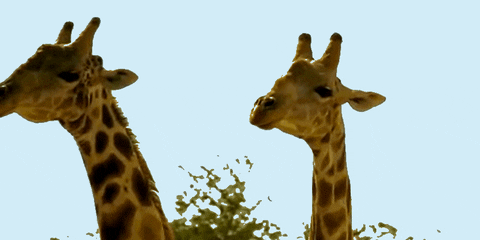
Giraffes are the tallest land animal and the largest ruminant on Earth. Their iconic long necks have fascinated scientists for centuries. Charles Darwin himself tried to explain such a bizarre evolution, proposing that the giraffe’s long necks are an adaptation that helped them reach an otherwise untouchable source of food — treetop leaves.
But in the mid-1990s, researchers offered a different take. They proposed the “necks-for-sex” hypothesis based on the behavior of male giraffes. These males compete for dominance by swinging their necks and delivering blows to each other with their heavy skulls and the small horns (conical skin-covered bone structures) on their heads. In other words, giraffes evolved long necks so that males could bash their heads harder and impress ladies.
So, giraffes’ long necks may be explained by either forces that enhance their survival (natural selection) or helping to secure mates (sexual selection). Which is it though? A new study suggests that both evolutionary pressures may have compounded, contributing to the giraffe’s enormously long neck today.
Complex Neck Proportions
Researchers led by Penn State biologist Doug Cavener analyzed thousands of photos of wild and captive Masai giraffes (Giraffa tippelskirchi). Since ascertaining size from pictures alone is challenging, they focused on body proportions, comparing the length of the neck to the overall height of the animals.
When they’re born, males and females have the same body proportions and typically stay that way until the giraffes reach sexual maturity at around age three. This is when the males start exploding in size, differentiating themselves from the much smaller females. However, the analysis revealed that females have proportionately longer necks and trunks (their bodies). Meanwhile, the males have longer forelegs and wider necks.
“The necks-for-sex hypothesis predicted that males would have longer necks than females,” said Cavener.
“And technically they do have longer necks, but everything about males is longer; they are 30% to 40% bigger than females. In this study, we analyzed photos of hundreds of wild and captive Masai giraffes to investigate the relative body proportions of each species and how they might change as giraffes grow and mature.”
“Interestingly, giraffes are one of few animals whose height we measure to the top of the head — like humans — rather than to their withers — the highest part of the back, like in horses and other livestock,” Cavener said. “The female has a proportionally longer axial skeleton — a longer neck and trunk — and are more sloped in appearance, while the males are more vertical.”

Nature vs. Romance
Giraffes are very picky eaters that will only eat the leaves and twigs of acacia, mimosa, and wild apricot trees. Cavener notes that giraffes — and especially females — will rarely stretch out their necks to reach the tallest branches in a canopy. Instead, they like to use their long necks to reach deeper into the tree to grab leaves that no one can.
“Once females reach four or five years of age, they are almost always pregnant and lactating, so we think the increased nutritional demands of females drove the evolution of giraffes’ long necks,” the biologist said.
Meanwhile, the male’s broad neck is an adaptation for fighting with other males. When giraffe bulls engage in a brawl, whether to solve mating or territory rights, they use the momentum of their long necks to powerfully thrust with the horn-like structures that cover their heads. If the target is hit, the opponent can be severely wounded and even killed.

Giraffes take these fights seriously and won’t engage in serious jousts unless they don’t have a choice. And, like professional fighters, the males will often practice by sparring with eager opponents from the same herd. One interesting 2021 study found that the giraffes even seem to have ‘rules’ that we humans may judge as honorable. Powerful and large males don’t take advantage of their status by picking on someone younger and smaller. Instead, the giraffes spar only with opponents in their league.
Additionally, the longer forelegs of males may assist in mating. Giraffe sex is a very brief and challenging affair that is rarely observed.
So, the giraffe’s long neck first evolved because it helped them secure more calories. Later, sexual selection might have made the male’s necks broader. This distinction underscores how sexual selection shaped the males’ physical traits, whereas natural selection influenced the females’ evolution.
Knowledge and Conservation
This new understanding of giraffes’ neck evolution underscores the importance of conserving their habitat. The decline in Masai giraffe populations over the past 30 years, driven by habitat loss and poaching, makes it critical to protect their environment.
The research offers fresh insights into giraffe biology and highlights the complex interplay between natural and sexual selection. By understanding these dynamics, scientists can better devise conservation strategies to protect these majestic creatures.
The findings appeared in the journal Mammalian Biology.
Was this helpful?



